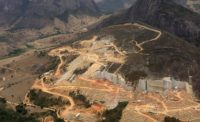Since that time, the buzzword for stone materials around the world -- particularly Brazilian materials -- has been "exotics." Whether you work with them or not, pretty much everyone in the stone industry knows about them, and we see them at all of the trade shows. They are typically found in colors and patterns not seen elsewhere, and they are well suited for homeowners who want countertops that are different than the ones in their neighbor's kitchen. A number of stone suppliers and fabricators have reported that by selling exotics, they are setting themselves apart from competition that sells on the basis of price, since $25-per-square-foot kitchens are rarely processed out of these materials.
So we know what exotics are and what they mean to the marketplace, and there are plenty of photos of "exotic" quarries out there. Stone World publishes them all of the time, and there are more than 20 of them in our feature on Everest Export.
But while we hope to do a nice job of giving you the "nuts and bolts" of these exotic quarries -- material appearance, production rates, block sizes, extraction processes, etc. -- it can sometimes be difficult to express the lengths that the stone producers go to in order to find these materials.
In preparing my article on Everest Export, I traveled to the state of Ceará, Brazil, where I visited a number of quarry sites, and while all of them had quite a story to tell, I was compelled to share one of my experiences with family and friends even before I returned home. The following is an excerpt of my dispatch from Brazil:
Last Thursday, we went to a quarry site that is still in development, and hasn't been accessed since January. It is truly in the middle of nowhere -- even by Brazilian standards.
Anyhow, my host (an American who has been living in Brazil for 14 years) hadn't been there in awhile, and he explained that he always was a passenger during past visits, so he needed some assistance finding the site. There was nothing but the very occasional cluster of modest homes, but we stopped and asked directions. The guy inside one of them ended up jumping in with us to help show the way. We went a little ways, but then our journey sort of petered out, so then we stopped at another residence and found a different guy who knew where we wanted to go, and so he joined the car ride. However, he cautioned us that the road leading to the quarry site can be tricky, and insisted on bringing his hatchet to clear any downed trees that might be blocking the road.
The locals seemed like nice enough guys, but I couldn't help but think, "OK, this is where the two Americans disappear in the remote Brazilian backcountry while searching for a quartzite deposit."
But as it turns out, the locals could not have been more helpful. They knew the lay of the land, and they showed us right to the quarry site. The "quarry road" would scarcely qualify as a backcountry hiking trail, but we made it there safe and sound, and I even posed for a photo with the guys -- and the hatchet.
The quartzite in that quarry site -- named "Nocciola," the Italian word for "hazelnut" -- was quite nice, and some blocks had even been slabbed for the Vitória Stone Fair in February. But at the time of my visit, it still felt like one of the most remote places I had ever seen. As it turns out, there is a road being developed between this area and the mid-sized city of Sobral, so the backcountry adventures there may become a bit more limited, but I am sure they will continue elsewhere in the hills of Ceará.
My point here is to illustrate how much time, effort and money goes into finding these exotic materials and to highlight how each one has a story that goes along with it. After we visited the Nocciola site, while I was content to sit in the air-conditioned truck, my American host and owner of Everest Export, Richard Sardelli, went on to examine several other sites for quartzite in the immediate area. And he continues to do so long after my return home, seeking materials that will have a long-term impact in the American marketplace and beyond.
The point of all this is that at a time when many companies are looking for an angle that will set themselves apart from the competition, exotics might provide the edge -- and story -- you need to stand apart.





